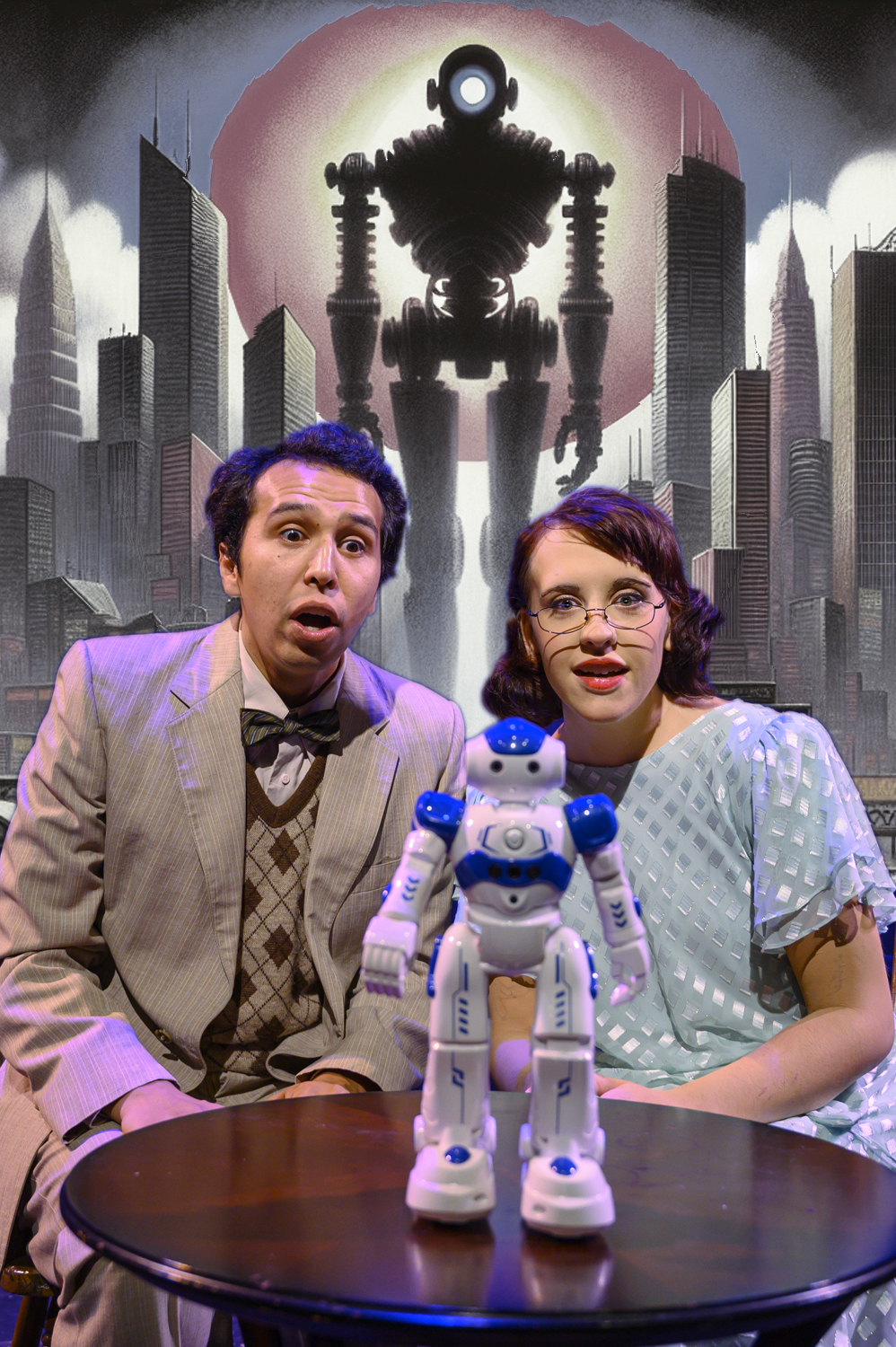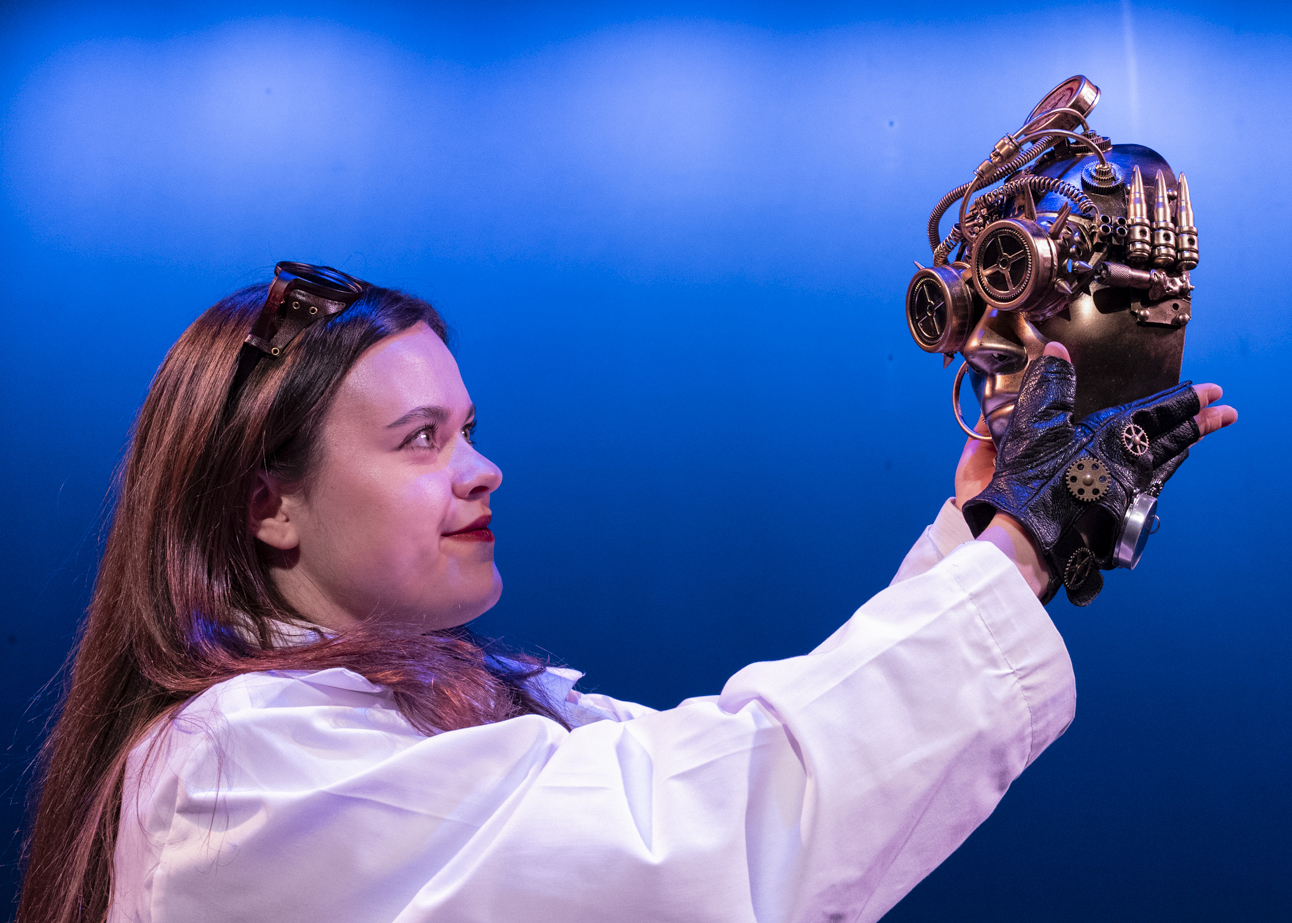
Theatre Arts
R.U.R. Study Guide

By Kim Hing
R.U.R.—Rossum’s Universal Robots is a futuristic, science fiction tale written in 1920 by Karel Capek and adapted by Bo List in 2013 for a high school in Kentucky. It received a world-wide premiere at City Lit Theatre Company in Chicago in 2025 and is now having its West coast premiere at Foothill College.
The play is set in the Hall of Robots, a showroom, at Rossum’s Universal Robots’ factory. We meet Harry Rossum, Director General of R.U.R., an eccentric, impulsive, ambitious, and nervous man practicing his welcome speech for the President’s daughter, Helena Glory, with Tibia, one of his robots. Helena plans to inform Harry that she will be speaking at the World’s Fair and to read her speech to him. She belongs to the Robot Defense League and wants to ensure that robots are treated humanely and with respect.
Harry will also be attending the Fair, only he will be revealing his latest line of robots that look, walk, and speak like humans. R.U.R.’s robots have been getting better on their own by becoming smarter, despite no modifications being made to their programming. Harry is excited about this and believes that the benefits his new robots will bring to people are limitless. They will do all the labor, all the work, all the drudgery.
The key ingredient in these marvelous robots is Automated Ingenuity, A.I. Created by Harry’s father, it is used as the final step in making a robot. Harry is the only one currently possessing it. A.I. allows robots to think and make decisions as long as it is within their programming. Only the robots are thinking outside their programming.
Meanwhile, Harry instantly falls in love with Helena and they quickly marry. But what happens while they are away on their honeymoon? The robots develop feelings and opinions. They are tired of being ordered around. Since they do all the work, are humans necessary? The robots think not and start a revolution. Who ends up on top? The robots or the humans?

Director’s Note
By Bruce McLeod
Perhaps like yours, my high school history teacher taught me to view historical events as potential harbingers of actions in our own time. In college, I learned to use theatrical storytelling as way to invite audiences into a conversation about their current world.
Now, as a director, I find myself searching for classic plays that might best illuminate the concerns of today in our rapidly changing culture.
A play that I first read in college, R.U.R., struck me as a powerful reflection of the social upheavals of the 1920s—it showed strong female characters, the clash of traditional industrial revolution practices with the promise of automation, and the emergence of workers’ rights and opportunities for a new utopian vision. The play was rooted in the question, “What is humanity’s place in the universe?”
At the time, I did not recognize how prescient Čapek had been in 1920. Certainly robots, the word he coined for the play, would become a foundational part of literature and pop culture for the next 100 years, almost immediately spawning films, books, and later television shows, anime, and more, centered on mechanical marvels. But it wasn't until recently that robots became a real part of our lives (anyone take a Waymo to the theatre tonight?) and now our thoughts have returned to Čapek's major theme: what part can/should/must humans play in the evolution of artificial intelligence? What happens when our creations are capable of out thinking us?
When I recently reread R.U.R. with the thought of directing it, I found its story just as inspirational — but knew it would be difficult to produce. The original language was archaic, the plot seemed unnecessarily complex, and the characters were hard to relate to. In a stroke of good fortune, my colleague Milissa Carey sent me a review of a recent Chicago production of R.U.R. that featured a brand-new adaptation. It sounded perfect—a fresh, humorous look at the characters and the story. I immediately contacted the author of this new adaptation, Bo List, and within days of reading the script, we were off and running! I hope you find his take on this classic as enjoyable and thought-provoking as I have.
And now, thanks to original author Karel Čapek, playwright Bo List, and the many others who have joined the always collaborative journey that is live theatre, I am very happy to present the west coast premiere of R.U.R.—Rossum's Universal Robots.

The Playwright — Bo List
Bo List is an award-winning writer, director, producer, and educator, based in Lexington, Kentucky. As a playwright, he is best known for his adaptations of Frankenstein (published by Dramatic Publishing), R.U.R. (Rossum's Universal Robots) (soon to be published by Broadway Play Publishing), The Last Dracula, and the original plays Ladies of Liberty and Ghost Music. One-acts include Canary Yellow (winner of the Father Jeff Hamblin Award from Abingdon Theatre Company, NYC), I Left My Heart in Kissimmee, Clink, Bubbly, Tide, and Gilbert. He also writes one-person, touring historical dramas for Kentucky Humanities with subjects including Abraham and Mary Todd Lincoln, Nancy Green, Daniel Boone, and his great-great-great-great-great grandfather, Henry Clay. List is a proud member of the Dramatists Guild of America and an MFA graduate of the University of Memphis Department of Theatre and Dance.

The Original Playwright — Karel Čapek
By Kim Hing
Karel Čapek was born on Jan. 9, 1890 in Malé Svatoňovice, Bohemia, which at the time was part of Austria-Hungary, and now is in the Czech Republic. His father was a country doctor, and his mother gathered local folk tales. Čapek struggled with health issues from an early age. According to History Tools, he developed spinal tuberculosis as a child, and the condition caused him to experience bone deterioration and spinal cord compression. This disability contributed to his decision to become a novelist, short-story writer, playwright, journalist, and philosopher. In 1928, Čapek said, “I write only because I cannot work regularly at a job, otherwise believe me, I would not write.”
Early on, Čapek displayed a rebellious streak. He was told to change high schools when he was caught belonging to an underground student club. Thus, he went to Brno to live with his older sister and finish school. Čapek continued his studies at Charles University in Prague, Berlin, and Paris cumulating in doctorate in philosophy. While visiting Spain, he observed the 1923 fascist coup. History Tools explains that the experience affected him severely and caused him to condemn both fascism and communism as “totalitarian threats to humanism and pluralism.”
Beginning in 1917, Čapek devoted his time to writing. His literary pieces primarily centered on philosophical ideas concerning humankind’s attempts to escape the confined circle of fate and understand definitive values. He also explored how scientific findings and technological innovations lure people into colossal uprisings. His most famous play, R.U.R: Rossum’s Universal Robots epitomized this. Published in 1920, it was produced in 1921 in Progue and later in New York City. Shortly after that, it was translated into 30 languages. History Tools noted that, “According to reviews, spectators found the drama about the existential threat posed by the robots “engrossing” and “thought-provoking” for its inventive concept and warning message about the hubris of playing god.
While the word “robot” has been in our vocabulary for seemingly ever, it was actually coined by Čapek’s older brother, Josef. When Čapek was unable to come up with a name for his human looking laborers, he asked Josef for suggestions. Josef came up with “Robata”, meaning drudgery or forced labor in Czech.
When thinking about what a robot looks like, do images of C3PO or R2D2 come to mind? Would it surprise you that that is not at all what Čapek had in mind? IEEE Spectrum published part of an article by Karel Čapek that was published in Lidové noviny, June 9, 1935. In that article, Čapek expressed his dismay over what robots had become. He insisted that, “For his robots were not mechanisms. They were not made of sheet metal and cogwheels. They were not a celebration of mechanical engineering. If the author was thinking of any of the marvels of the human spirit during their creation, it was not of technology, but of science.”
He then goes on to explain, “The author of the robots appeals to the fact that he must know the most about it: and therefore, he pronounces that his robots were created quite differently—that is, by a chemical path. The author was thinking about modern chemistry, which in various emulsions (or whatever they are called) has located substances and forms that in some ways behave like living matter. He was thinking about biological chemistry, which is constantly discovering new chemical agents that have a direct regulatory influence on living matter… the way he imagined it, he created only a new foundation for life, which began to behave like living matter… The author did not intend to furnish the world with plate metal dummies stuffed with cogwheels, photocells, and other mechanical gizmos.” Therefore, we have had the wrong idea of what a robot is for all this time.
Karel Čapek died of pneumonia on December 25, 1938. His book War on Newts, a satirical science fiction novel showing his unease over imperialism and fascism, and other antifascism writings caused him to be branded “public enemy number two” by the Gestapo. He died in Prague, and three months later the Gestapo came to arrest him not knowing he was already deceased.
A noteworthy fact about Čapek is that he was nominated for the Nobel Prize in Literature seven times! Unfortunately, he never won it. He is arguably the greatest Czech writer. The University of Oregon states that Arthur Miller said, “There was no writer like him... prophetic assurance mixed with surrealistic humour and hard-edged social satire: a unique combination."

Download a PDF copy of this R.U.R. Study Guide

Questions?
We're Here to Help!
Theatre Box Office
650.949.7360
Lohman Theatre, Bldg 8000
